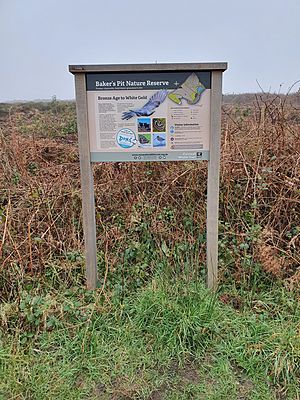Baker's Pit Nature Reserve facts for kids
Quick facts for kids Baker's Pit Nature Reserve |
|
|---|---|
 Baker's Pit Nature Reserve information board |
|
| Lua error in Module:Location_map at line 530: Unable to find the specified location map definition: "Module:Location map/data/Cornwall (mainland)" does not exist. | |
| OS grid reference | SW 480355 |
| Unitary authority | |
| Ceremonial county | |
| Region | |
| Country | England |
| Sovereign state | United Kingdom |
| Post town | PENZANCE |
| Postcode district | TR |
| Dialling code | 01736 |
| Police | Devon and Cornwall |
| Fire | Cornwall |
| Ambulance | South Western |
| EU Parliament | South West England |
| UK Parliament |
|
Baker's Pit Nature Reserve is a special place in west Cornwall, England. It's a nature reserve looked after by the Cornwall Wildlife Trust (CWT). This reserve is found on the open moorland called Noon Diggery. It's located just south of a very old hillfort named Castle-an-Dinas. Inside that hillfort, there's also a tower called Roger's Tower.
A really interesting feature at Baker's Pit is a unique, funnel-shaped area. It looks a bit like a "banjo enclosure." These are ancient sites from the Iron Age that were used for special ceremonies. This one is the only known "banjo enclosure" in all of Cornwall!
The land for the reserve was given to the Cornwall Wildlife Trust in the year 2000 by a company called Imerys. Part of the reserve used to be a china clay quarry, which means it was a place where a special type of clay was dug out of the ground.
Contents
What is Baker's Pit Nature Reserve?
Baker's Pit is a large nature reserve, covering about 45 hectares (that's like 111 football fields!). The Cornwall Wildlife Trust manages this area. It sits on the open moorland of Noon Diggery. This land is on the eastern edge of the granite uplands of Penwith in west Cornwall.
The closest village to the reserve is Nancledra. Baker's Pit is roughly halfway between the towns of Penzance and St Ives. On the southern side of the reserve, you'll find the Castle-an-Dinas quarry. Roger's Tower, a decorative building, stands on an Iron Age hillfort nearby.
The Rocks and Landscape
The rocks here are made of fine-grained granite. This granite is dug up and sold as china-stone. China-stone can be used for building things. When this granite changes into a soft, white material called kaolin, it becomes china clay. This china clay was once mined at Baker's Pit.
The reserve is mostly on a flat area called a plateau. It gently slopes down towards the south-east. There isn't much to block the strong winds that usually blow from the south-west.
How to Visit Baker's Pit
There isn't a car park right at the reserve. You can get there by driving on smaller roads off the B3311. Or, you can walk to the reserve using public footpaths.
Discovering the History of Baker's Pit
The high areas of West Penwith are famous for their ancient features. You can still see signs of how people lived and used the land long ago. These include places for ceremonies, settlements where people lived, and areas for farming animals. These old features are incredibly well-preserved here, better than almost anywhere else in Britain.
Ancient Field Systems
In 1979 and 1980, a survey was done on the Noon Diggery moorland. It found the remains of ten old field systems. Eight of these are inside the Baker's Pit nature reserve. Another three were found later by a different mapping project. These ancient field boundaries can be from the Bronze Age or the Romano-British period. That means they could be between 2,000 and 4,000 years old!
Burial Mounds and Ritual Sites
Within the reserve, there's also an early Bronze Age burial mound, called a barrow. You can see it clearly against the sky. These barrows were often the main focus of ancient settlements. Most barrows date from around 2000 to 1600 BC. There are also other low, stony mounds nearby. These might also be ancient sites used for special ceremonies.
China Clay Mining History
Records from 1873 show that a large china clay work and quarry belonged to a Mr. Baker of Amalveor. Twenty years later, in 1893, the records still mentioned these extensive works. This shows that Baker's Pit was an important place for mining china clay for many years.

